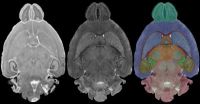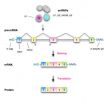Highly targeted radiation technique minimizes side effects of prostate cancer treatment
2010-10-26
(Press-News.org) Men with prostate cancer treated with a specialized type of radiation called intensity modulated radiation therapy (IMRT) have fewer gastrointestinal complications compared to patients treated with conventional three-dimensional conformal radiotherapy (3D-CRT), according to a study presented November 1, 2010, at the 52nd Annual Meeting of the American Society for Radiation Oncology (ASTRO).
"With survivors living many years after treatment, it is very important to minimize gastrointestinal and urinary side effects to allow patients to live a full life after treatment," Justin Bekelman, M.D., lead author of the study and a radiation oncologist at the University of Pennsylvania in Philadelphia, said. "We specifically looked at IMRT, given its potential to minimize radiation side effects and its higher cost compared to other treatments. Our study shows there is a benefit for men with prostate cancer to receive IMRT over conventional treatment in terms of gastrointestinal side effects. But there is no difference between the two treatments in terms of urinary side effects."
The prostate gland is near both the rectum and the bladder, so doctors must be very careful to spare these healthy tissues to avoid complications when attacking the cancer.
Prostate cancer is the most common cancer in American men, with more than 185,000 men diagnosed with the disease each year. Fortunately, the disease is very manageable and often curable, with 98 percent of patients living at least five years after their diagnosis.
IMRT and 3D-CRT are special types of external beam radiation therapy where radiation is directed through the skin to the cancer and the immediate surrounding area to destroy the tumor and any stray cancer cells. Treatments are painless, much like receiving an X-ray.
Policymakers and clinicians have highlighted the need for comparative studies of prostate cancer treatments. However, there is little evidence comparing IMRT to conventional radiation therapy. Three-dimensional conformal radiation therapy, or 3D-CRT, uses computers and special imaging techniques such as CT, MR or PET scans to show the size, shape and location of the tumor and surrounding organs. Because the radiation beams are very precisely directed, nearby normal tissue receives less radiation.
Intensity modulated radiation therapy, or IMRT, is a specialized form of 3D-CRT that better shapes the radiation to the tumor. Using IMRT, it may be possible to further limit the amount of radiation received by healthy tissue near the tumor.
This study used the Surveillance, Epidemiology and End Results (SEER)-Medicare database to compare the gastrointestinal and urinary complications of men 65 years or older with prostate cancer within two years of treatment with IMRT or 3D-CRT. The researchers specifically examined common gastrointestinal side effects like inflammation of the rectum lining (proctitis) and rectal bleeding, along with the urinary side effects like inflammation of the bladder tissue (cystitis) and blood in the urine (hematuria).
The study showed that IMRT was associated with a modest reduction in gastrointestinal complications associated with radiation, including proctitis and rectal bleeding. Urinary complications, such as cystitis and hematuria, did not significantly differ between the groups.
###
For more information on radiation therapy for prostate cancer, visit www.rtanswers.org.
The abstract, "Comparative Effectiveness Of Intensity-modulated (IMRT) versus 3-D Conformal (CRT) Radiotherapy for Non-metastatic Prostate Cancer," will be presented at a scientific session at 2:45 p.m. on Monday, November 1, 2010. To speak to the lead author of the study, Justin Bekelman, M.D., please call Beth Bukata or Nicole Napoli October 31 – November 2, 2010, in the ASTRO Press Room at the San Diego Convention Center at 619-525-6313 or 619-525-6314. You may also e-mail them at bethb@astro.org or nicolen@astro.org.
END
ELSE PRESS RELEASES FROM THIS DATE:
2010-10-26
A lower dose of radiation used to reduce side effects is not as effective as the regular dose when given with the standard chemotherapy in the treatment of Hodgkin's lymphoma patients with early, intermediate-stage disease, according to a first-of-its-kind randomized study presented at the plenary session, November 1, 2010, at the 52nd Annual Meeting of the American Society for Radiation Oncology (ASTRO).
In addition, the trial showed that a more intensive chemotherapy (BEACOPP) is not more effective than the standard chemotherapy treatment (ABVD) for these patients.
"This ...
2010-10-26
BOSTON (October 25, 2010) — Researchers from Tufts University pooled data from five previous epidemiological studies to investigate the prevalence of asthma in children in the Boston neighborhoods of Chinatown and Dorchester. Among children born in the United States, low socioeconomic status (SES) and exposure to pests (mice and cockroaches) were both associated with having asthma. Neither association was present in children born outside of the United States. The study was published online in advance of print in the Journal of Immigrant and Minority Health.
"In earlier ...
2010-10-26
Adding chemotherapy to radiation therapy for muscle invasive bladder cancer allows 67 percent of people to be free of disease in their bladders two years after treatment. This compares to 54 percent of people who receive radiation alone, according to the largest randomized study of its kind presented at the plenary session, November 1, 2010, at the 52nd Annual Meeting of the American Society for Radiation Oncology (ASTRO).
"The trial shows that this treatment offers improved control of cancer within the bladder with acceptable long-term side effects and is therefore a ...
2010-10-26
Stereotactic radiation is an effective, long-term treatment for trigeminal neuralgia: a painful condition that occurs with increased frequency in patients with multiple sclerosis (MS). Radiation is noninvasive and has less negative side effects than other treatments, according to the longest follow-up in a study of its kind presented October 31, 2010, at the 52nd Annual Meeting of the American Society for Radiation Oncology (ASTRO).
Multiple sclerosis is a progressive neurological disease affecting about 300,000 Americans where the body's immune system attacks its own ...
2010-10-26
Laxenburg, Austria – 26th October 2010 --
A new assessment of future scenarios that limit the extent of global warming cautions that unless current imbalances in R&D portfolios for the development of new, efficient, and clean energy technologies are redressed, greenhouse gas (GHG) emission reduction targets are unlikely to be met, or met only at considerable costs.
The study identifies energy efficiency as the single most important option for achieving significant and long-term reductions in GHG emissions, accounting for up to 50 percent of the reduction potential across ...
2010-10-26
ITHACA, N.Y. – The human hand is an amazing machine that can pick up, move and place objects easily, but for a robot, this "gripping" mechanism is a vexing challenge. Opting for simple elegance, researchers from Cornell University, University of Chicago and iRobot have bypassed traditional designs based around the human hand and fingers, and created a versatile gripper using everyday ground coffee and a latex party balloon.
They call it a universal gripper, as it conforms to the object it's grabbing rather than being designed for particular objects, said Hod Lipson, ...
2010-10-26
In scientific publishing, how much reuse of text is too much? Researchers at the Virginia Bioinformatics Institute at Virginia Tech and collaborators have shown that a computer-based text-searching tool is capable of unearthing questionable publication practices from thousands of full-text papers in the biomedical literature.
The first step in the process is to find out what is restated before zeroing in on who may have crossed an ethically unacceptable threshold. The findings, published in PLoS ONE, offer hope for curbing unethical scientific publication practice, ...
2010-10-26
VIDEO:
This video contains more on the pediatric bone cancer preclinical study.
Click here for more information.
BOSTON - Researchers have identified an important signaling pathway that, when blocked, significantly decreases the spread of pediatric bone cancer.
In their study, researchers at The University of Texas MD Anderson Children's Cancer Hospital in Houston found that blocking the Notch pathway in mice decreased metastases in the lungs 15-fold. The results of ...
2010-10-26
DURHAM, N.C. – The most detailed magnetic resonance images ever obtained of a mammalian brain are now available to researchers in a free, online atlas of an ultra-high-resolution mouse brain, thanks to work at the Duke Center for In Vivo Microscopy.
In a typical clinical MRI scan, each pixel in the image represents a cube of tissue, called a voxel, which is typically 1x1x3 millimeters. "The atlas images, however, are more than 300,000 times higher resolution than an MRI scan, with voxels that are 20 micrometers on a side," said G. Allan Johnson, Ph.D., who heads the ...
2010-10-26
PHILADELPHIA - When most genes are transcribed, the nascent RNAs they produce are not quite ready to be translated into proteins - they have to be processed first. One of those processes is called splicing, a mechanism by which non-coding gene sequences are removed and the remaining protein-coding sequences are joined together to form a final, mature messenger RNA (mRNA), which contains the recipe for making a protein.
For years, researchers have understood the roles played by the molecular machines that carry out the splicing process. But, as it turns out, one of those ...
LAST 30 PRESS RELEASES:
[Press-News.org] Highly targeted radiation technique minimizes side effects of prostate cancer treatment


